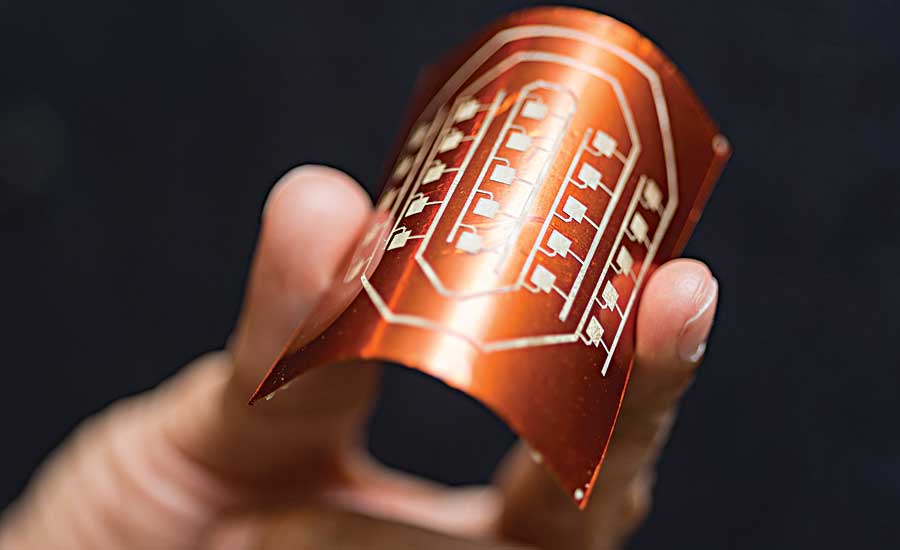Flexible Electronics-Start of New Era in Electronics
Imagine a whole new way of making electronics that’s like flexible, bendable magic. Instead of the usual stiff circuit boards, flexible electronics are made from materials that can twist, turn, and fit into all sorts of shapes. This amazing technology is set to change many things in our world because it can work in lots of different situations and unexpected places.
Fabrication Process
The fabrication of flexible electronics involves several production methods like printing, lamination, and deposition. These techniques enable the development of ultra-thin, lightweight, and incredibly flexible electronic parts like sensors, displays, and batteries. The fabrication process relies on various materials like conductive inks, polymers, and metals.
Flexible electronics manufacturing is a method of crafting electronic circuits and devices on bendable materials like plastic, paper, or fabric.
Key Materials for Fabrication Process
The Key materials needed for the fabrication process are conductive and substrate materials.
Conductive materials are special materials that help electricity flow. They are the wires of flexible devices. These materials can be thin silver wires, tiny carbon structures, or special types of plastics.
Silver Nanowires: These are like super-thin silver threads that can be put on a surface to make it conduct electricity. They are see-through, bendy, and great for things like touchscreens and solar panels.
Carbon Nanotubes: These are like super-tiny tubes made of carbon atoms. They are very light, flexible, and can carry electricity well. They are used in things like sensors and batteries.
Conductive Polymers: These are special plastics that can also carry electricity. They are light and can be put on surfaces in different ways. People use them in things like flexible screens, sensors, and solar panels.
Substrate materials give support to the parts that carry electricity. These materials have to be flexible, tough, and able to withstand the making process. Common materials used for this job are:
Polyimide: It’s a strong and bendable material that can handle high temperatures. People use it in flexible displays, touchscreens, and printed circuit boards.
Polyester: This material is both flexible and tough, making it perfect for things like flexible displays, sensors, and solar cells.
Polyethylene Terephthalate (PET): This is a see-through, bendy material commonly used in touchscreens, displays, and solar cells.
Technologies used in the manufacturing of Flexible Electronics
The manufacturing of innovative gadgets involves various technologies to make them bend, twist, and fold to fit our needs. The two primary technologies involved are printing Technologies and Deposition technologies.
Printing technologies: These technologies are a popular choice in flexible electronics manufacturing because they offer a cost-effective and scalable way to make flexible electronic gadgets. The common printing methods:
Inkjet Printing: This is like a special printer that sprays ink onto a surface to make designs. People use it a lot for printing conductive inks on flexible materials.
Screen Printing: Imagine a mesh screen that presses ink onto a surface to create patterns. It’s great for making big designs on flexible stuff.
Flexographic Printing: This one uses a bendy printing plate to put ink on a surface. It’s handy for creating detailed patterns on flexible materials.
Another way to manufacture flexible electronics is by using deposition technologies. These methods are about adding super-thin layers of stuff onto a surface to create electronic devices. The most common deposition technologies:
Physical Vapor Deposition (PVD): This method puts a material onto a surface by turning it into vapor (like steam) or using a process called sputtering. People often use PVD to put metals and metal oxides onto flexible materials.
Chemical Vapor Deposition (CVD): A material is deposited onto a surface by making it react chemically. CVD is handy for adding thin layers of organic materials onto flexible stuff.
Atomic Layer Deposition (ALD): ALD is like putting one layer at a time onto a surface. It’s good for adding thin layers of insulating materials onto flexible materials.
Applications
The world of consumer electronics is undergoing a remarkable transformation due to flexible electronics. They have the ability to craft screens, batteries, and sensors that can bend and flex. This technology produced a new wave of products has emerged, including foldable smartphones, smartwatches, and fitness trackers. Some important applications of flexible electronics are healthcare, automobiles, jewelry, protective devices
Challenges in the implementation of flexible electronics
Cost: The major drawback in flexible electronics manufacturing is managing costs. The materials and techniques used to create flexible electronics are often expensive compared to those in traditional electronics manufacturing.
Reliability: The next challenging factor is reliability since it undergoes various physical changes, such as bending, folding, and stretching, which can potentially harm the components or connections.
Scalability: The next challenge in flexible electronics is scalability flexible electronics have the potential for large-scale production, but the processes involved are often more complicated and time-consuming compared to traditional electronics manufacturing.
Conclusion
Flexible electronics have the ability to create electronic devices that can bend, stretch, and conform to various shapes opening up a range of possibilities across different industries. However, there are some challenges such as manufacturing costs, reliability, and scalability have led to important areas for further research and development. We can expect innovative applications in many fields with the rapid advancement of flexible Electronics.
Source
- https://www.frontiersin.org/articles/10.3389/felec.2020.594003/full
- https://onlinelibrary.wiley.com/doi/abs/10.1002/adma.202211202
- https://hillmancurtis.com/flexible-electronics-manufacturing-2/

